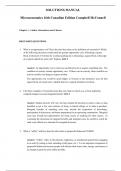SOLUTIONS MANUAL
Microeconomics 16th Canadian Edition Campbell McConnell
Chapter 1 - Limits, Alternatives and Choices
DISCUSSION QUESTIONS
1. What is an opportunity cost? How does the idea relate to the definition of economics? Which
of the following decisions would entail the greater opportunity cost: Allocating a square
block in the heart of Toronto for a surface parking lot or allocating a square block at the edge
of a typical suburb for such a lot? Explain. LO1.2
Answer: An opportunity cost is what was sacrificed to do or acquire something else. The
condition of scarcity creates opportunity cost. If there was no scarcity, there would be no
need to sacrifice one thing to acquire another.
The opportunity cost would be much higher in Toronto as the alternative uses for that
square block are much more valuable than for a typical suburban city block.
2. Cite three examples of recent decisions that you made in which you, at least implicitly,
weighed marginal cost and marginal benefit. LO1.2
Answer: Student answers will vary, but may include the decision to come to class, to skip
breakfast to get a few extra minutes of sleep, to attend college, or to make a purchase.
Marginal benefits of attending class may include the acquisition of knowledge,
participation in discussion, and better preparation for an upcoming examination. Marginal
costs may include lost opportunities for sleep, meals, or studying for other classes. In
evaluating the discussion of marginal benefits and marginal costs, be careful to watch for
sunk costs offered as a rationale for marginal decisions.
3. What is “utility” and how does the idea relate to purposeful behaviour? LO1.2
Answer: “Utility” refers to the pleasure, happiness, or satisfaction gained from engaging
in an activity (eating a meal, attending a ball game, etc.). It is an important component of
purposeful behaviour because people will allocate their scarce time, energy, and money in
an attempt to gain the most utility possible.
,Chapter 01 - Limits, Alternatives, and Choices
4. What are the key elements of the scientific method and how does this method relate to
economic principles and laws? LO1.3
Answer: The key elements include the gathering of data (observation), the formulation of
possible explanations (hypothesis), testing the hypothesis, determining the validity of the
hypothesis, and repeated testing of hypotheses that have appeared to be valid in prior tests.
The scientific method is the technique used by economists to determine economic laws or
principles. These laws or principles are formulated to explain and/or predict behavior of
individuals or institutions.
5. Make (a) a positive economic statement of your choice, and then (b) a normative economic
statement relating to your first statement. LO1.4
Answer: Student answers will vary. Example: (a) The unemployment rate is 6.8 percent;
(b) the unemployment rate is too high. In general, we treat “what is” statements as positive,
“what should be” as normative, but keep an eye out for statements like “at full employment
an increase in the production of pizzas should come at the cost of less robots.” Some
students may incorrectly identify the statement as normative because of the term “should.”
6. How does the slope of a budget line illustrate opportunity cost and trade-offs? How does a
budget line illustrate scarcity and the effect of limited incomes? LO1.5
Answer: Budget lines are always sloped downward. This downward slope shows an
inverse relationship between the two goods, meaning that as you increase one, the other
must decrease. This decrease is what you are giving up, or opportunity cost, of the good
you are getting more of.
Budget lines illustrate scarcity in that they show you are limited by your income. Since
they slope downward, they show you cannot keep getting more and more of both goods.
There is always a trade-off. The area beyond the budget line represents combinations of
the goods that are beyond your income.
,Chapter 01 - Limits, Alternatives, and Choices
7. What are economic resources? What categories do economists use to classify them? Why are
resources also called factors of production? Why are they called inputs? LO1.6
Answer: Economic resources are the natural, human, and manufactured inputs used to
produce goods and services. Economic resources fall into four main categories: labour,
land (natural resources), real capital (machines, factories, buildings, etc.,) and
entrepreneurs. Economic resources are also called factors of production because they are
used to produce goods and services. They are called inputs because they go in to a
production process (like ingredients go into a bowl to make a cake), with the resulting
goods and services also being referred to as output.
8. Why is money not considered to be a capital resource in economics? Why is entrepreneurial
ability considered a category of economic resource, distinct from labour? What are the major
functions of the entrepreneur? LO1.6
Answer: Money is not considered a capital resource because money is not productive – it
provides access to resources but itself does not directly contribute to the production of
goods and services. Additionally, the quantity of money in circulation does not determine
an economy’s productive capacity, while the amount of capital and other resources does.
Doubling the amount of money in circulation does not change the economy’s physical
capacity to produce goods and services. Money is, however, referred as a financial
resource and financial capital, reflecting its ability to acquire real economic resources.
Entrepreneurial ability and labour are both human resources, but they perform different
functions in the productive process. Entrepreneurial ability does not directly produce goods
and services; it organizes the resources that do. Labour refers to the human inputs that
directly engage in production.
Entrepreneurs are risk-takers: They coordinate the activities of the other three inputs for
profit—or loss, which is why they are called risk-takers. Entrepreneurs sometimes manage
companies that they own, but a manager who is not an owner is not necessarily an
entrepreneur but may be performing some of the entrepreneurial functions for the company.
Entrepreneurs are also innovators, or perhaps inventors, and profits help to motivate such
activities.
, Chapter 01 - Limits, Alternatives, and Choices
9. Specify and explain the typical shapes of marginal-benefit and marginal-cost curves. How are
these curves used to determine the optimal allocation of resources to a particular product? If
current output is such that marginal cost exceeds marginal benefit, should more or fewer
resources be allocated to this product? Explain. LO1.7
Answer: The marginal benefit curve is downward sloping; MB falls as more of a product
is consumed because additional units of a good yield less satisfaction than previous units.
The marginal cost curve is upward sloping, MC increases as more of a product is produced
since additional units require the use of increasingly unsuitable resource. The optimal
amount of a particular product occurs where MB equals MC. If MC exceeds MB, fewer
resources should be allocated to this use, as the additional cost is more than the additional
benefit.
10. Suppose that, on the basis of a nation’s production possibilities curve, an economy must
sacrifice 10,000 pizzas domestically to get the 1 additional industrial robot it desires but that
it can get the robot from another country in exchange for 9,000 pizzas. Relate this
information to the following statement:
“Through international specialization and trade, a nation can reduce its opportunity cost of
obtaining goods and thus ‘move outside its production possibilities curve.’” LO1.8
Answer: The message of the production possibilities curve is that an individual nation is
limited to the combinations of output indicated by its production possibilities curve.
International specialization means directing domestic resources to output which a nation is
highly efficient at producing. International trade involves the exchange of these goods for
goods produced abroad. Specialization and trade have the same effect as having more and
better resources or discovering improved production techniques. The output gains from
greater international specialization and trade are the equivalent of economic growth.





